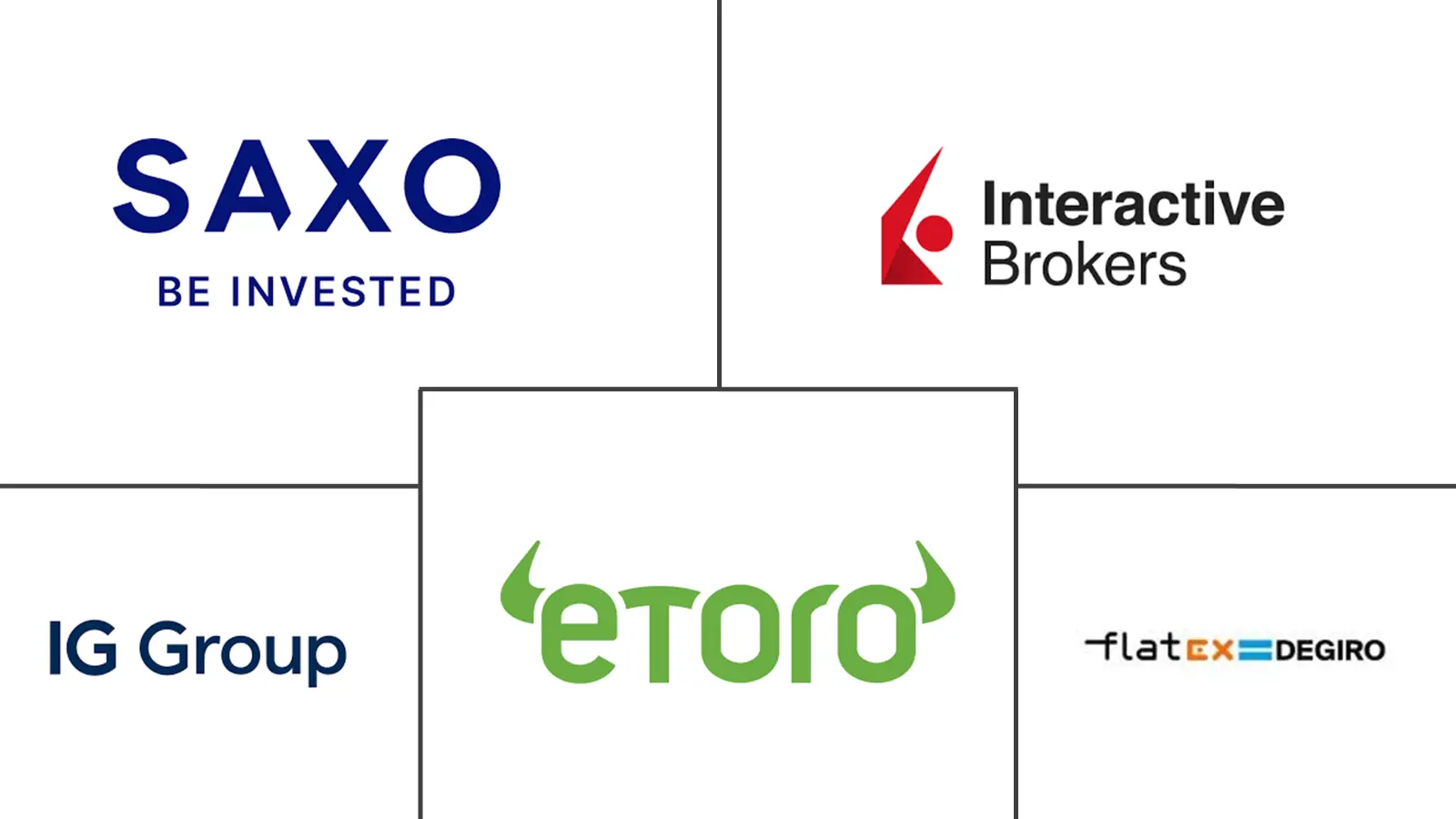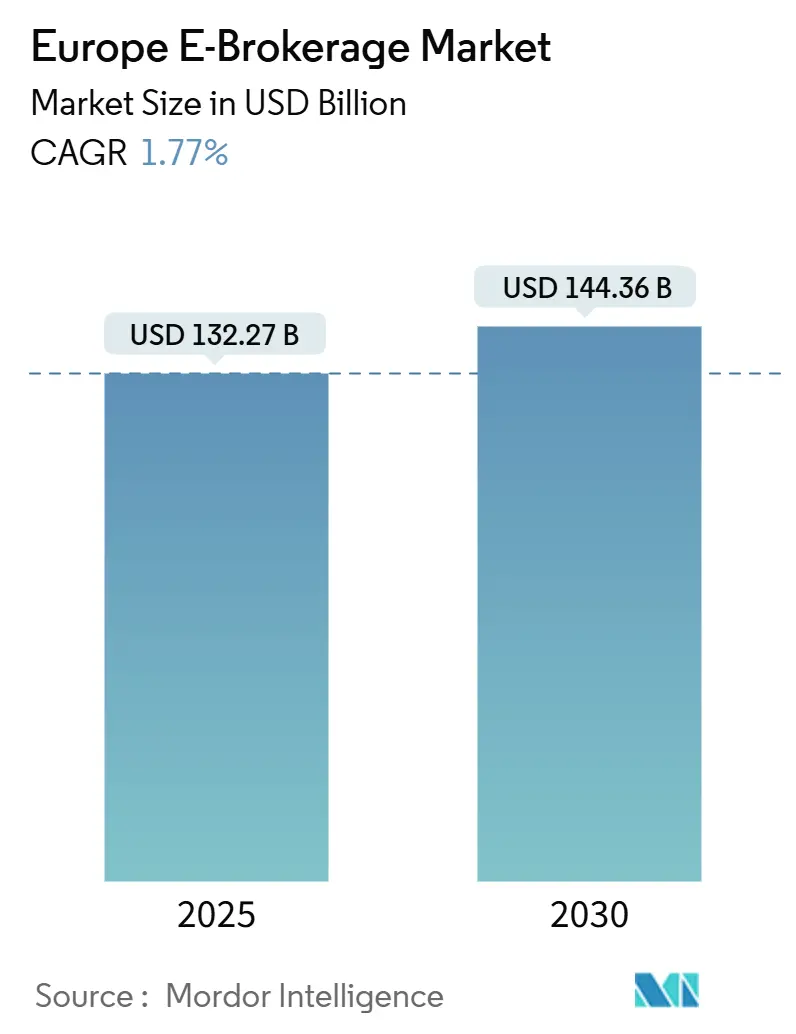
Europe E-Brokerage Market Analysis by Mordor Intelligence
The Europe e-brokerage market size stands at USD 132.27 billion in 2025 and is forecast to reach USD 144.36 billion by 2030, reflecting a 1.77% CAGR across the outlook period. Measured expansion signals a maturing competitive arena in which regulatory compliance costs and mounting price pressure reshape revenue models, while technology innovations such as embedded finance and Banking-as-a-Service unlock fresh income streams. MiFID II amendments, DORA enforcement from January 2025, and the Payment-for-Order-Flow ban due July 2026 together redefine operating rules, elevating transparency and resilience expectations. Discount platforms have forced fee compression that reverberates throughout the European e-brokerage market, and major players now concentrate on scale, profitability, and superior digital experience to defend margins. Cross-border activity intensifies as consolidated tape initiatives harmonize execution data, bolstering liquidity and encouraging investors to diversify across European venues.
Key Report Takeaways
- By investor type, retail investors captured 70.27% of the Europe e-brokerage market share in 2024, while the institutional segment is projected to advance at an 8.72% CAGR through 2030
- By services offered, discount brokers held 55.31% of the Europe e-brokerage market size in 2024 and are expanding at a 10.33% CAGR to 2030.
- By operation, domestic trading accounted for 64.26% of the Europe e-brokerage market size in 2024; foreign operations record the fastest 9.48% CAGR through 2030.
- By geography, the United Kingdom led with 26.14% of the Europe e-brokerage market share in 2024, while Spain posts the highest 9.87% CAGR to 2030.
Europe E-Brokerage Market Trends and Insights
Drivers Impact Analysis
| Driver | (~) % Impact on CAGR Forecast | Geographic Relevance | Impact Timeline |
|---|---|---|---|
| PSD-2 driven account aggregation adoption | +0.3% | EU-wide, strongest in Germany and Netherlands | Medium term (2-4 years) |
| MiFID II fueled demand for commission transparency | +0.4% | EU-wide, particularly UK and France | Short term (≤ 2 years) |
| Rise of zero-commission freemium pricing models | +0.5% | Global, led by Germany and Nordic countries | Short term (≤ 2 years) |
| Cloud-native trading cores lowering barrier to entry | +0.2% | EU-wide, concentrated in fintech hubs | Long term (≥ 4 years) |
| Embedded-brokerage APIs in neobanks and super-apps | +0.3% | EU-wide, strongest in UK and Germany | Medium term (2-4 years) |
| Tokenized securities pilots on DLT rails | +0.1% | EU-wide, early adoption in Switzerland and Germany | Long term (≥ 4 years) |
| Source: Mordor Intelligence | |||
PSD-2 Driven Account Aggregation Adoption
Second-generation payment services rules let investors consolidate multi-bank portfolios on one screen, widening access to integrated wealth dashboards that combine savings, credit, and trading accounts [1] European Banking Authority, “PSD-2: Third-Party Provider Register,” eba.europa.eu. Licensed third-party providers now exceed 3,000 across the EU, powering neobanks that fold brokerage into daily banking flows. Dutch and German consumers exhibit the strongest uptake, and aggregated data enables brokers to offer personalized tax and portfolio insights formerly reserved for private-bank clients. Lower churn and deeper engagement translate to 25% lower acquisition costs for platforms with mature aggregation engines. PSD-2 security standards also form a regulatory moat that limits copy-cat entrants lacking robust data-protection frameworks.
MiFID II Fueled Demand for Commission Transparency
Revised MiFIR rules from 2024 force granular cost disclosure and dismantle bundled fee models, pushing investors toward platforms with clear, low-charge structures[2]European Securities and Markets Authority, “MiFID II & MiFIR Review 2024,” esma.europa.eu. Discount brokers use transparent pricing to capture share from legacy full-service houses still adjusting to unbundled research and dual UK-EU compliance frameworks. French retail clients reacted quickly; low-fee brokers gained 15% share in 2024 as investors shifted away from bank-owned networks. Independent research providers flourish under unbundling, while large banks lose the soft advantage once held by proprietary analysis. Compliance outlays that approach EUR 50 million a year for top brokers entrench scale benefits enjoyed by market leaders.
Rise of Zero-Commission Freemium Pricing Models
Commission-free execution is baselining expectation across the Europe e-brokerage market, with 67% of new investors under thirty-five opening their first account on fee-free apps. Platforms replace transaction income with premium analytics, securities lending, and subscription bundles, enabling profitability once scale cross’s critical mass. Nordic adoption remains highest as Swedish and Danish users display 78% preference for zero-commission venues. Incumbent brokerages respond by unbundling advisory and charging tiered packages, yet legacy cost bases hamper swift realignment. ESMA’s ongoing review tightens disclosure rules, favoring transparent models positioned for the Payment-for-Order-Flow ban in 2026.
Cloud-Native Trading Cores Lowering Barrier to Entry
Modern brokers deploy fully containerized trading stacks that auto-scale in milliseconds and cut upfront infrastructure outlay by as much as 80% versus on-premises builds. Providers such as lemon markets supply turnkey APIs that banks integrate to launch brokerage in weeks rather than quarters. European data-residency rules spur regional cloud vendors to offer compliant zones, reducing reliance on non-EU hyperscalers. Elastic capacity proved vital during 2024 volatility spikes when trade volumes tripled without downtime. With execution commoditized, platforms now compete on user interface, regulatory depth, and ecosystem partnerships impossible to replicate through technology alone.
Restraints Impact Analysis
| Restraint | (~) % Impact on CAGR Forecast | Geographic Relevance | Impact Timeline |
|---|---|---|---|
| Proposed EU FTT (Financial-Transaction-Tax) | -0.4% | EU-wide, particularly high-frequency trading markets | Medium term (2-4 years) |
| Heightened cyber-resilience mandates (DORA) raising compliance costs | -0.3% | EU-wide, disproportionate impact on smaller brokers | Short term (≤ 2 years) |
| Declining order-flow payments amid regulatory scrutiny | -0.2% | EU-wide, affecting commission-free business models | Short term (≤ 2 years) |
| Retail order-execution quality investigations (under-reported) | -0.2% | EU-wide, focus on market makers and execution venues | Medium term (2-4 years) |
| Source: Mordor Intelligence | |||
Proposed EU FTT (Financial-Transaction-Tax)
Draft legislation imposes 0.1% on equity and 0.01% on derivatives trades, which models suggest could shave 15–25% off retail volumes and redirect liquidity to offshore venues. France’s 2012 levy already cut local turnover by 18%, offering precedent for market migration risks. Discount brokers operating on thin spreads are least able to absorb the charge, raising questions about the endurance of free trading post-implementation. Cross-border trades, 34.9% of Nordnet flows, face the greatest disruption as investors may shift orders outside the EU to avoid tax drag. Asset-management groups warn the tax could reduce EU GDP 0.28% a year by suppressing capital-market efficiency.
Heightened Cyber-Resilience Mandates (DORA) Raising Compliance Costs
DORA, enforced EU-wide since January 2025, mandates continuous monitoring, third-party risk audits and incident-reporting that cost mid-scale brokers EUR 2–5 million annually. Extraterritorial reach ensnares non-EU firms serving European clients, dissuading smaller foreign entrants. Heavy emphasis on cloud-provider oversight compels renegotiation of service-level agreements and inflates technology bills. Fixed compliance expenses equal a larger revenue slice for niche fintechs, accelerating acquisition by better-capitalized rivals. Although resilience boosts market confidence, resources diverted to audits curb budgets for product rollouts and geographic expansion.
Segment Analysis
By Investor Type: Retail Momentum Reshapes Product Roadmaps
Retail investors controlled 70.27% of the European e-brokerage market in 2024, reflecting an era of democratized finance powered by mobile onboarding, fractional trading, and social-network features [3]Trade Republic GmbH, “Company Update 2025,” traderepublic.com. Their 8.72% CAGR to 2030 outpaces institutional growth as Gen-Z savers swap savings deposits for ETF portfolios and crypto allocations. Platforms such as Trade Republic steward more than EUR 100 billion of retail assets and extend multilingual apps across eighteen countries, confirming pan-continental appetite for low-friction investing. Institutional desks pivot to white-label APIs from Saxo Bank, which services 150 partners managing EUR 118 billion in client funds, proving digital rails now underpin both segments [4]Saxo Bank A/S, “Annual Report 2024,” home.saxo. Robust KYC automation, PSD-2 data feeds, and DORA-compliant infrastructure together uphold trust critical for scaling mass-market propositions.
Leading brokers exploit network effects by adding community feeds, thematic baskets, and ESG filters that deepen engagement and generate data for tailored cross-selling offers. Trade Republic’s profitability milestone in 2023 shows that scale can offset compressed commissions when alternative revenue lines mature. Institutional traders embrace algorithmic order management through Banking-as-a-Service stacks, trimming custody expenses while meeting MiFID II research unbundling obligations. Convergence blurs lines: some retail apps now offer level 2 depth and options chains; conversely, institutional portals adopt consumer-grade UX. The European e-brokerage market still prizes regulatory compliance as a baseline, and large actors with dedicated governance teams cement loyalty among both investor classes.
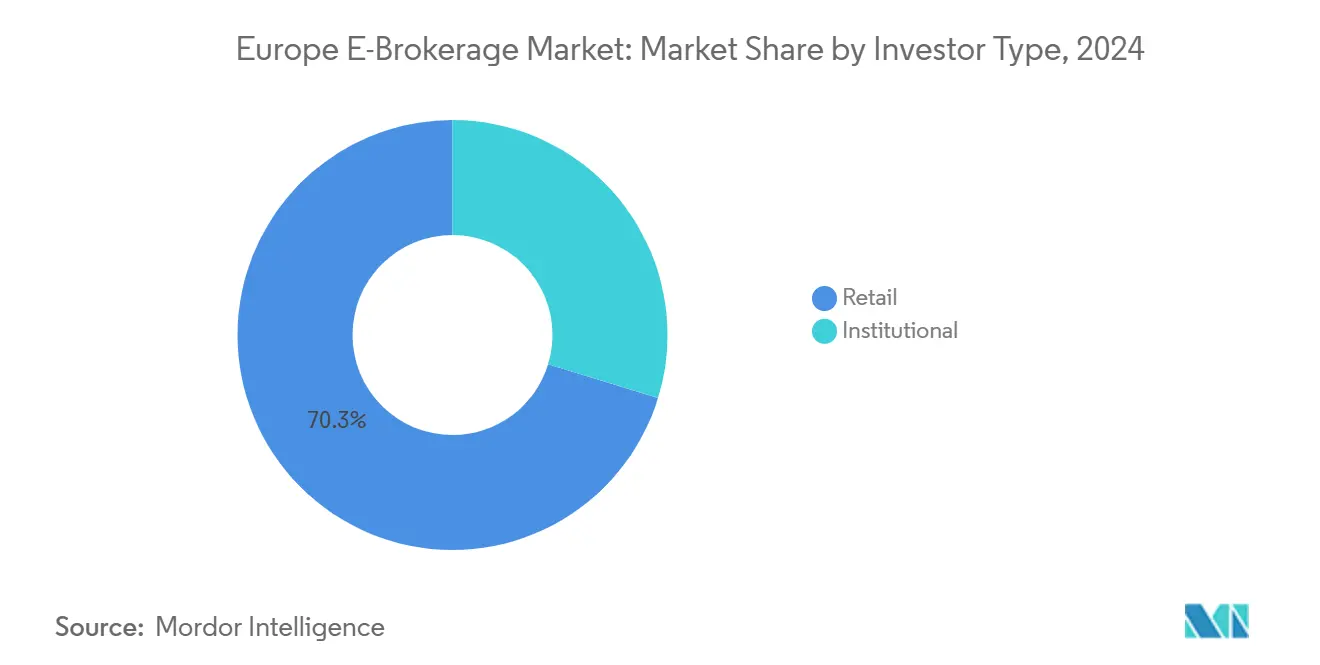
Note: Segment shares of all individual segments available upon report purchase
By Services Offered: Discount Dominance Challenges Legacy Economics
Discount brokers occupied 55.31% of the European e-brokerage market share in 2024, a position they secured through algorithmic cost control, automated onboarding, and transparent pricing that resonates with value-seeking users. The cohort’s 10.33% CAGR to 2030 illustrates continued migration from branch-centric banks to digital-only storefronts. FlatexDEGIRO processed 63 million trades in 2024 for 2.9 million clients, proving that low-cost at scale can underpin sustainable profit pools. Full-service incumbents pivot to tiered subscription packages that separate execution from advisory, thereby preserving high-touch wealth-management margins. Yet cost gaps persist as branch networks keep fixed overhead that digital rivals lack.
Discount houses extend product depth into research notes, rob-allocation, and retirement wrappers once monopolized by full-service peers, eroding the latter’s differentiation. Technology centers on streaming data, conversational AI support, and embedded credit, capabilities that widen moat versus newcomers. Full-service brokers lean on complex tax advice, estate planning, and alternative asset access to retain affluent cohorts, but those services command premium fees only a fraction of the addressable market will accept. Regulation again shapes battlefield: MiFID II cost-transparency rules spotlight hidden mark-ups, steering clients toward low-fee offers. Only platforms balancing rock-bottom execution with compelling UX and diversified incomes will thrive.
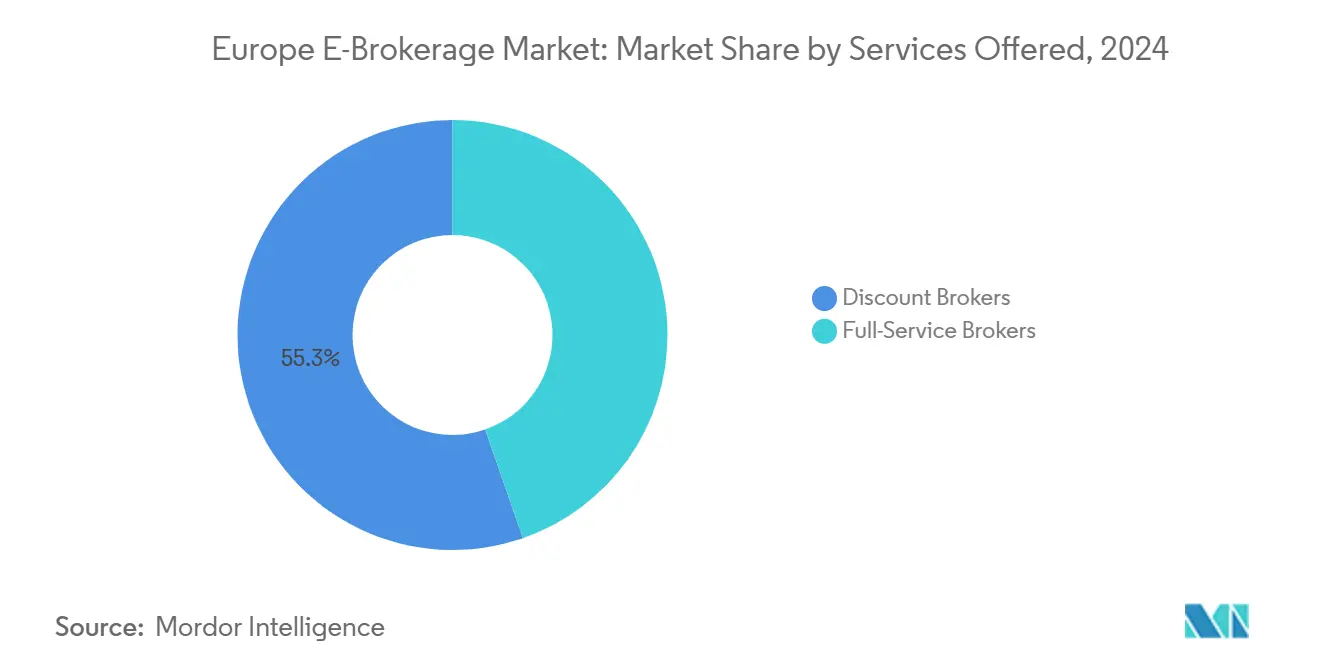
Note: Segment shares of all individual segments available upon report purchase
By Operation: Cross-Border Growth Signals Continental Integration
Domestic activity still generated 64.26% of the Europe e-brokerage market size in 2024, underscoring investor comfort with local-currency accounts and familiar regulatory protections. However, foreign-operation volume is surging 9.48% CAGR through 2030 as consolidated tape architecture promises harmonized pricing and seamless settlement across EU exchanges. Nordnet already records 34.9% cross-border trades on its platform; forthcoming German launch aims to replicate Scandinavian success by leveraging a multilingual, multi-currency core. Brexit forces dual U.K.–EU frameworks yet has not dampened British investors’ appetite for euro-denominated assets, nor European clients’ interest in FTSE equities.
Greater cross-border convenience demands that brokers master real-time FX conversion, local tax calculation, and passported compliance, elevating technology barriers for smaller firms. Young investors comfortable with app-based ID verification show markedly higher foreign-asset allocations than older cohorts. Corporate clients pursuing pan-European employee-equity plans seek single-stack providers that handle settlement in multiple authorities, creating B2B growth avenues. Regulators encourage integration to deepen capital pools, though anti-money-laundering checks remain firmly national. As harmonization advances, operational excellence will determine who scales beyond home markets without eroding margins.
Geography Analysis
E-Brokerage Market in Other Countries
The United Kingdom retained a 26.14% share of the European e-brokerage market in 2024 despite post-Brexit fragmentation that mandates dual compliance for brokers serving EU clients. British users display advanced digital habits, and the recent IG Group acquisition of Free Trade for GBP 160 million expands mobile reach among millennials. FCA rule divergence on crypto, short selling, and PFOF shapes distinct propositions that some pan-European players perceive as an opportunity rather than a burden. Shifting from explosive pandemic-era growth, U.K. brokers now optimize profitability via securities-lending desks and subscription analytics that soften commission squeeze. London’s status as a global finance hub underpins robust institutional flows even as retail enthusiasm moderates.
Spain is the fastest-moving market with 9.87% CAGR projected through 2030, buoyed by the rapid digitalization of a historically under-invested retail base. Trade Republic plans to establish local banking status in 2025, dovetailing with CNMV measures that heighten product scrutiny and boost consumer trust. Young Spaniards embrace ETFs and fractional equities, migrating capital from low-yield deposits. Platforms investing in Spanish-language support and domestic tax navigation outpace rivals relying solely on English portals. Harmonized EU frameworks allow Spanish investors broader exposure while maintaining strong national protection, sustaining double-digit expansion.
Germany, France, Italy, and Nordics form the mature core where incremental growth hinges on share capture rather than market expansion. flatexDEGIRO leads in Germany with 2.9 million accounts, leveraging ultralow fees to fend off new entrants. France’s PEA tax wrapper attracts brokers rolling out dedicated interfaces and local custody to win seven million eligible investors. Nordnet’s SEK 983 billion client assets underscore Nordic sophistication: its push into Germany tests scalability against entrenched domestic names. BENELUX consolidation continues with ABN AMRO acquiring BUX for EUR 68 million to blend banking depth with fintech speed. Regionally diverse regulation, language, and tax codes ensure that even large platforms must balance centralized tech with finely tuned local operations.
Competitive Landscape
Competitive intensity sits at moderate-to-high levels as the European e-brokerage market features a handful of scale leaders and a long tail of niche specialists. FlatexDEGIRO, eToro, and Saxo Bank anchor the top tier via complementary models: cost leadership, social-community investing, and institutional white-labeling, respectively. Consolidation accelerates; IG Group’s purchase of Free Trade, J. Safra Sarasin’s majority stake in Saxo, and ABN AMRO’s buyout of BUX prove that scale remains the most reliable hedge against tightening rules. Technology excellence defines the competitive edge: leading apps deploy cloud-native cores, AI-driven personalization, and plug-and-play APIs that slot into neobanks and super-apps.
Revenue diversification matters more as commission lines shrink; successful brokers draw on securities lending, premium analytics subscriptions, and data monetization. White space remains in underserved territories such as Spain or thematic niches like ESG fractional baskets and tokenized shares, pending clearer EU legislation. July 2026’s PFOF ban will evaluate the balance sheets of brokers reliant on order-flow rebates, triggering new merger rounds. DORA compliance capacity has morphed into a defensive moat; firms with in-house cyber teams attract B2B custody and execution mandates from banks lacking digital muscle.
New disruptors bet on embedded-finance alliances, plugging investment widgets into everyday finance apps to reach customers at the point of need. Meanwhile, incumbent universal banks explore partnerships to retool outdated brokerage portals rather than build anew. In this arms race, only platforms blending regulatory rigor, cost efficiency, and engaging UX can sustain margins as price transparency deepens.
Europe E-Brokerage Industry Leaders
-
eToro Ltd.
-
DEGIRO / flatexDEGIRO AG
-
Saxo Bank A/S
-
IG Group Holdings plc
-
Interactive Brokers LLC
- *Disclaimer: Major Players sorted in no particular order
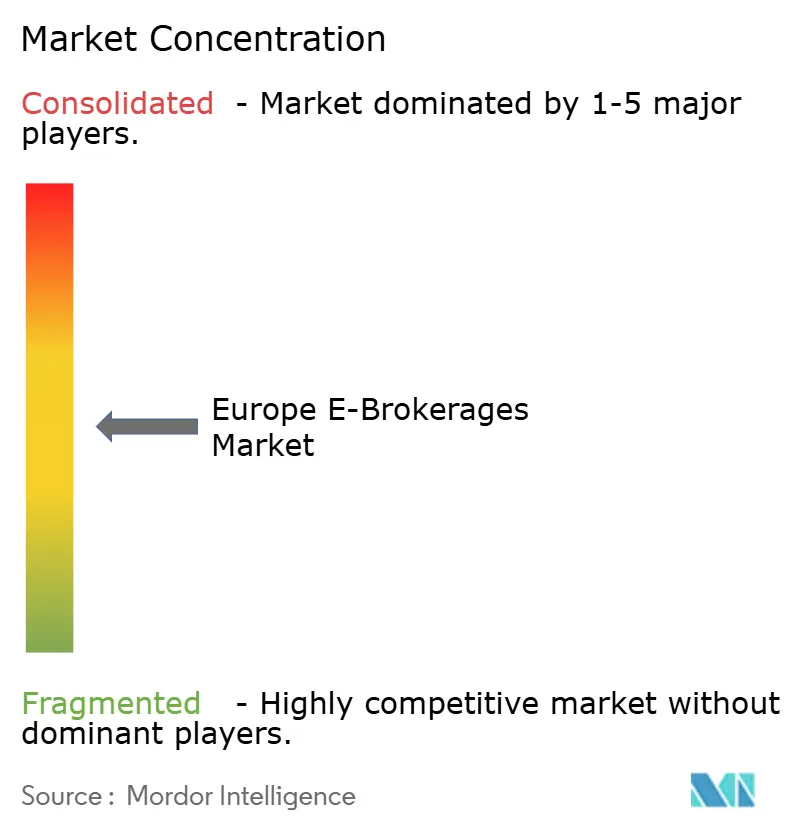
Recent Industry Developments
- June 2025: Fabrick acquired 75% of finAPI to accelerate open-banking and embedded-finance expansion in Germany and Austria, leveraging finAPI’s API stack for rapid cross-sell of brokerage modules.
- May 2025: lemon.markets partnered with Optio Incentives to enhance its Brokerage-as-a-Service platform by introducing an equity-compensation tool, providing digital infrastructure for employee stock programs, and supporting stock-option plans across Europe.
- January 2025: IG Group completed its USD 201.04 million (GBP 160 million) acquisition of Free Trade, adding 720,000 clients and USD 3.14 billion (GBP 2.5 billion) in assets, strengthening its United Kingdom retail market position and expanding trading, investment offerings, and customer segment access.
Europe E-Brokerage Market Report Scope
A broker is a person or business between a potential investor and a securities exchange. A company serving as a customer's agent and receiving payment from the customer in the form of a commission is known as a broker. The online service it provides in exchange for fees is an e-brokerage service. A complete background analysis of the Europe E-Brokerage Market includes an assessment of the economy, a market overview, market size estimation for key segments, emerging trends in the market, market dynamics, and key company profiles covered in the report. Europe E-Brokerages Market can be segmented by Investor Type (Retail and Institutional), by Services Offered (Full Time Brokers and Discount Brokers), by Operation (Domestic and Foreign), and by Geography (Germany, United Kingdom, Russia, Spain, Netherlands, Denmark, Sweden, Finland, Norway, and the Rest of Europe). The report offers market size and forecasts for Europe E-Brokerage Market in value (USD million) for the above segments.
| Retail |
| Institutional |
| Full-Service Brokers |
| Discount Brokers |
| Domestic |
| Foreign |
| United Kingdom |
| Germany |
| France |
| Spain |
| Italy |
| BENELUX (Belgium, Netherlands, and Luxembourg) |
| NORDICS (Denmark, Finland, Iceland, Norway, and Sweden) |
| Rest of Europe |
| By Investor Type | Retail |
| Institutional | |
| By Services Offered | Full-Service Brokers |
| Discount Brokers | |
| By Operation | Domestic |
| Foreign | |
| By Geography (Europe) | United Kingdom |
| Germany | |
| France | |
| Spain | |
| Italy | |
| BENELUX (Belgium, Netherlands, and Luxembourg) | |
| NORDICS (Denmark, Finland, Iceland, Norway, and Sweden) | |
| Rest of Europe |
Key Questions Answered in the Report
How large is the Europe e-brokerage market in 2025?
The Europe e-brokerage market size is USD 132.27 billion in 2025 and is projected to grow to USD 144.36 billion by 2030 at a 1.77% CAGR.
Which investor group dominates European digital brokerage?
Retail investors hold 70.27% share in 2024 and are expanding fastest thanks to mobile apps, commission-free pricing, and social trading tools.
What service model is growing quickest across the region?
Discount brokers post the strongest 10.33% CAGR to 2030 as transparent fee structures draw customers from traditional full-service firms.
Which country is the fastest-growing e-brokerage market?
Spain leads with a forecast 9.87% CAGR driven by rising retail participation and new entrants investing in localized digital platforms.
How will the Payment-for-Order-Flow ban affect European brokers?
The July 2026 ban will remove a key income source, favoring platforms that already rely on subscriptions, securities lending, and white-label B2B revenues.
Page last updated on:
